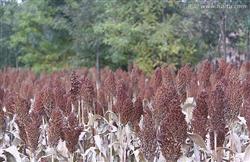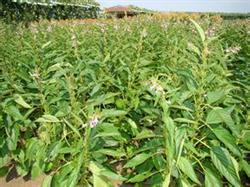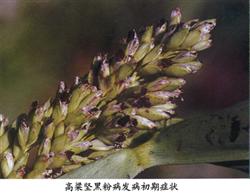How to diagnose and treat smut of sorghum

Smut often occurs in the growth process of sorghum, the yield reduction is usually 5% to 10%, the more serious disease can be up to 80%. Smut is a key disease control in sorghum production. 1. There are three symptoms of sorghum smut, namely scattered smut, head smut and head smut. The diseased ear of loose smut and its grains and inner and outer glumes all turn into black powder and are covered with a dark gray film. In the later stage, the film is easy to break, and the black powder is scattered after breaking, leaving a long axis. The diseased plant was slightly shorter than the healthy plant, and the heading was earlier than the healthy plant. The diseased ear and grain of hard smut are gray and oblong, full of black powder inside, thin film on the outside, very hard and not easy to break. The whole ear of head smut turns into a gray bag with a white film on the outside. When the disease is mature, the gray bag is easy to break, giving off a large amount of black powder, leaving a black messy silk like hair. two。 Seed transmission is the main infection route of hard smut and loose smut, while head smut is mainly caused by soil. All the three pathogens invaded the seedlings after sowing and invaded the ear during heading to form diseased ear with the growth of the plant. Generally, after sowing, the temperature is low, the emergence of seedlings is slow, and the disease is easy to occur, and the disease is serious in continuous cropping land or the application of bacteria-carrying fertilizer. 3. Control methods (1) rotation, selection of disease-resistant varieties: rotation for more than 3 years, selection of disease-resistant varieties, timely cultivation, diseased plants were found to be uprooted before the black powder was scattered, burned or buried in time. (2) seed dressing. For every 100 kg of seeds, choose: 25% vermicellin wettable powder 0.4 kg or 20% verapamil EC 1.25 liters or 50% carbendazim wettable powder 0.7 kg with proper amount of water and mix the seeds. Mix seeds evenly, generally pile up for 4 hours after mixing, and sow seeds after drying.
- Prev

Cultivation technique of Spring Sesame with plastic Film mulching
The main results are as follows: 1. The selection of high-yield and disease-resistant varieties shows that selecting a good variety is the guarantee of high yield. Ezhi No.2 has the characteristics of wide adaptability, good high yield and strong resistance, and its yield per mu is generally in 130~150kg. At present, it has been popularized and cultivated in a large area. 2. The sesame seeds of fine soil preparation are smaller.
- Next

Rational fertilization in Sorghum cultivation
What kinds of smut are there in sorghum? Scattered smut, hard smut and head smut are common in North China. (1) Sorghum loose smut: whole ear or part of grain is damaged. Before the diseased grain breaks, there is a gray-white film, which spreads out black powder (bacteria) after the film is broken, exposing a long and curved axis, which is sorghum scattered ear.
Related
- The first cup of black tea in spring, the flavor and history of tea gardens in Kenya, Africa
- The computer can not only choose potatoes, but also grow tea rice. AI will grow winter oolong tea champion.
- It is not only the inflated tea bitten by insects, but also engraved with the four seasons tea in Beipu.
- The Oriental Beauty Tea Festival in Zhuxian County takes the stage at the weekend to experience the plus-size feast of oil tea.
- & quot; Oriental Beauty Tea & Exploration of Emei in Hsinchu, the hometown of quot;
- The new variety of strawberry "Tainong 1" dessert is the first choice with mellow aroma. Crimson gorgeous
- History of Tea in Taiwan: from Wild Inner Mountain to Export Tea Garden
- Two types of Taiwan Oriental Beauty Black Tea won the British three-Star Award for Childhood Tea Xiang Zhang Jiaqi changed from pilot to champion tea maker.
- Banana species and varieties: the planting history of Taiwan Xianren banana and dwarf banana is long, is banana disease resistant?
- Coffee planting Technology: Qianjie Coffee from Seedling to harvesting

